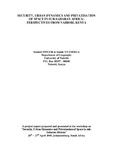| dc.contributor.author | Owuor, SO | |
| dc.contributor.author | Nyandega, I | |
| dc.date.accessioned | 2013-07-01T12:23:14Z | |
| dc.date.available | 2013-07-01T12:23:14Z | |
| dc.date.issued | 2003 | |
| dc.identifier.citation | 2003. Owuor, S.O. & I. A. Nyandega (2003), Security, urban dynamics and privatisation of space in sub-Saharan African cities: Perspectives from Nairobi, Kenya. IFAS Workshop. Johannesburg, South Africa, April 23-25.. | en |
| dc.identifier.uri | http://profiles.uonbi.ac.ke/samowuor/files/2003_joburg_workshop.pdf | |
| dc.identifier.uri | http://hdl.handle.net/11295/43433 | |
| dc.description.abstract | One of the major social maladies that has in the recent times plagued urban centres of
the world in general and Africa in particular, is insecurity. On the streets of major
African cities and in almost all the residential neighbourhoods, instances of crime are
becoming a normal daily occurrence. In Kenya, insecurity, especially in Nairobi, has
become a national problem that threatens the fabric of the society and its institutions.
It is hardly an exaggerated fact that most of us have been a victim of crime at one
point or the other. Urban crime in Kenya is a manifestation of the high rate of
urbanization process, which is associated with many socio-cultural, economic,
political and environmental problems.
The consequence of the increased insecurity in Nairobi has been the rise in: the
number of private security companies; car identification and immobilization systems;
chainlink fencing; concrete panel walls; electric gates and barriers; electric perimeter
fencing; computerized burglar alarms; mobile private security vehicles; private gates
and security guards; warnings of “mbwa kali”
1
; high walls and gates with razor wires;
radio back-up services; and the privatisation of space at the neighbourhood level.
This is an exploratory research project on “Security, Urban Dynamics and
Privatisation of Space in Sub-Saharan African Cities: A Case Study of Johannesburg,
Nairobi and Ibadan”. The Nairobi project is being conducted by the French Institute
for Research in Africa (IFRA - Nairobi) in collaboration with expertise from the
Department of Geography, University of Nairobi. A similar project is going on in
Ibadan (Nigeria) and Johannesburg (South Africa). The main objective of this study is
to develop a Geographic Information System (GIS) research program on urban
security in these three African cities.
The objectives of this phase of the research were:
1. Observation and mapping of security point locations organized by the residents’
neighbourhood associations.
2. Observation and mapping of environmental areas (with homogeneous
characteristics).
3. Conducting qualitative interviews with a few selected chairpersons of the
residents’ neighbourhood associations.
4. Administering quantitative questionnaires to a sample of chairpersons (or any
other authorized official) of the residents’ neighbourhood associations.
5. Production of three types of GIS layers: (1) security point location layer indicating
the access type in each location; (2) street access type layer; and (3)
environmental area type layer.
This report presents the various aspects of the research project that were undertaken
by the Nairobi team. It is intended to give an overview of the areas identified for the
project; methodological approaches; data set development and treatment; GIS
database and mapping; methodological challenges and considerations for the next
phase; analysis of the GIS layers; and the results emanating from the fieldwork.
1 A Swahili warning of “a fierce dog” (inside this compound) | en |
| dc.language.iso | en | en |
| dc.title | Security, urban dynamics and privatisation of space in sub-Saharan African cities | en |
| dc.type | Presentation | en |
| local.publisher | Department of Geography and Environmental Studies, Faculty of Arts, University of Nairobi | en |

